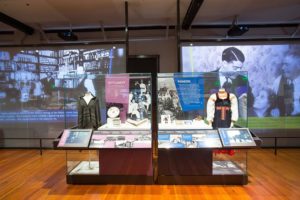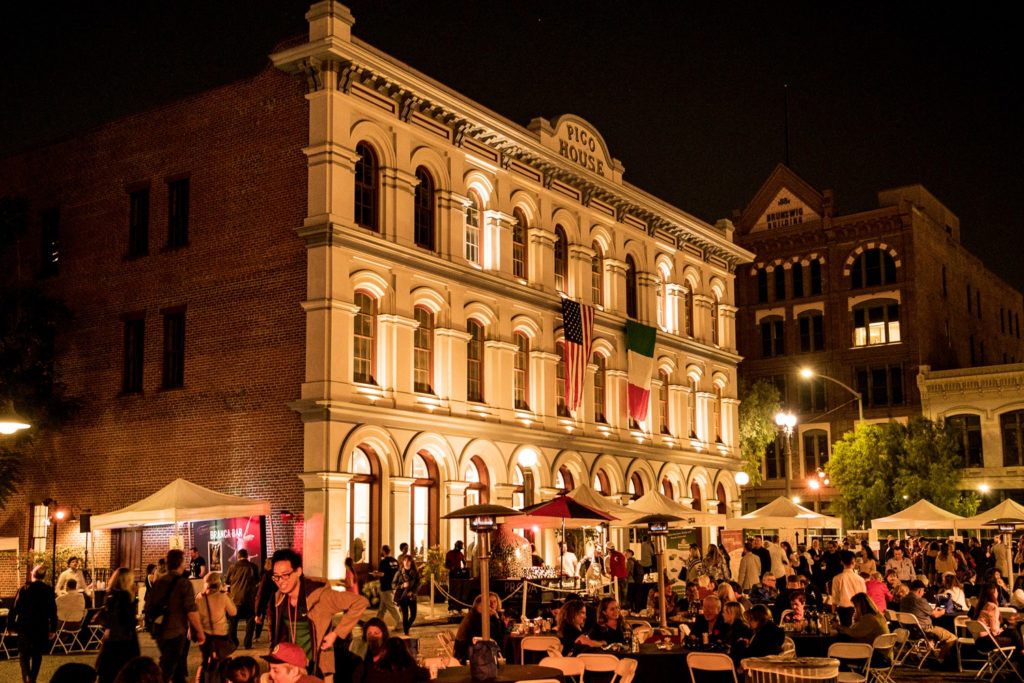The Italian American Museum of Los Angeles (IAMLA) is located in downtown’s Italian Hall at 644 North Main.
Built in 1908 as a community center, the hall is one of the oldest remaining structures in historic Little Italy and is listed on the National Register of Historic Places.
I can only speak for myself, but I didn’t even know we had a Little Italy.
I’m not alone. As the museum’s website points out, greater LA has the fifth largest Italian population of any U.S. city. Southern California’s Italian roots predate the nation’s founding. Italians and Italian Americans played key roles in the growth of Los Angeles as a major metropolis.
Still, our Italian population is seldom mentioned in historical narratives and even today, remains little remarked upon or noticed.
The museum boasts an award-winning permanent exhibition, temporary exhibitions, cultural-educational programming, and resources for educators. Admission is free.
Like other immigrants, Italians faced considerable prejudice and discrimination in the 19th and early 20th centuries, particularly in the American South. Eugenicists deemed Italians genetically inferior and they were popularly depicted as threats to racial and political purity.
The West, as is so often the case, proved more hospitable. Italians first permanently settled in the region after Mexico gained independence from Spain in 1821.
By 1850 they had gained a firm foothold. Italians excelled at agriculture and the vineyards they established near what is now downtown LA proved so profitable that Olvera Street was originally named Wine Street.
By the late 1800s, present-day Chinatown comprised much of LA’s Little Italy. Meanwhile, Italian enclaves extended from downtown into Lincoln Heights and Frogtown, while fishermen of Italian and Sicilian descent flocked to San Pedro’s waterfront.

St. Peter’s Italian Catholic Church on North Broadway and Mary Star of the Sea Church served the faithful of, respectively, downtown and San Pedro. Today, both are still vibrant parishes. St. Peter’s offers Masses in Italian and delights in observing feast days of saints connected to the towns where Italian Angelenos have roots. Their celebrations for St. Joseph in March and Santa Lucia in December are especially spirited.
But even after firmly establishing themselves geographically, economically, socially, and culturally, Italians still faced formidable obstacles. In the early days of film they were almost inevitably portrayed as either peasants or gangsters, with the latter stereotype continuing till the present day.
By 1940, millions of native-born Italians had become American citizens. An estimated 600,000 more, who had immigrated to the U.S. but not become naturalized citizens — and many of whom had raised families here — were classified “enemy aliens.”
Here’s a little-known fact: Though the persecution was not nearly as severe as that suffered by Japanese-Americans, hundreds of Italian Americans were restricted, relocated, and interned during World War II.
Italian Americans have a long history in Southern California of upholding the First Amendment and labor rights. Superior Court judge Alfred Paonessa (1901-1990) was instrumental in outlawing the Ku Klux Klan in the state of California and eliminating racially restrictive covenants that prohibited minorities from living in certain neighborhoods.
LA’s Italian artists include Simon Rodia, architect of the world-renowned Watts Towers, and John Fante, whose best-known novel, “Ask the Dust,” takes place in Depression-era Bunker Hill and follows the story of struggling writer Arthur Bandini.
Some things never change.
IAMLA’s collection includes 6,000 artifacts, archives, photos, and objects. Ranging in time from the 18th century to the present, the repository is the only one of its kind in the Western U.S.
Recent temporary exhibits have included “A Real Boy: The Many Lives of Pinocchio,” “Woven Lives: Exploring Women’s Needlework from the Italian Diaspora,” and “St. Joseph’s Tables: Expressions of Devotion, Charity, and Abundance.”
The site even provides helpful YouTube videos with instructions on how to cook homemade pasta, cannoli, eggplant parmigiana, Sicilian fig cookies, and more.
Speaking of food, the museum sponsors an annual “Taste of Italy” celebration, featuring scores of greater LA’s best Italian restaurants, wineries galore, and live entertainment.
This year’s gala took place on Saturday, Sept. 23, at Pico House, just down the street from IAMLA.
To whet your appetite, take an online audio tour of the museum’s award-winning permanent exhibit.
There are short pieces on history, culture, the Italian Hall, discrimination against Italians, and even Italians in Hollywood.
Which brings me to how I learned of IAMLA in the first place.
Earlier this year, I wrote a column entitled “Film noir: Where crime doesn’t pay.” A few months later, I received an email from Gregory Polito, a physician in Texas whose grandfather, cinematographer Sol Polito, shot three films with the great Barbara Stanwyck: “Woman in Red “(1935), “The Gay Sisters” (1942), and the classic “Sorry, Wrong Number” (1948) with Burt Lancaster as Stanwyck’s co-star.
Polito sent along three signed photos that Stanwyck had presented to his grandfather in appreciation for each of the three times they worked together. He’s also written a biography of Sol Polito, not available for sale to the public, a copy of which he’s donated to IAMLA.
So many threads connect us. How wonderful to learn of this paean to the history and culture of one of them: the Italian American population of LA.

